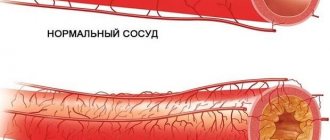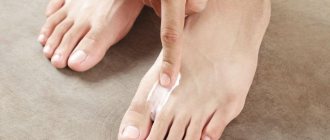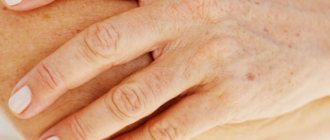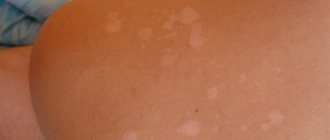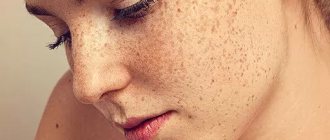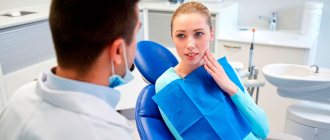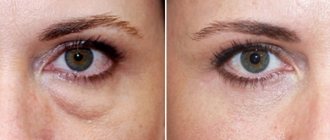Possible causes of age spots
Among the main reasons that cause the appearance of unsightly age spots on the face are the following:
- Hereditary predisposition. Such spots include, for example, nevi, which are formed due to the uneven formation and distribution of melanin in skin cells. Most often they are beige or brown in color. Every person has a certain number of congenital age spots. However, if they begin to enlarge, become injured, or there are too many of them, this can lead to the development of cancer, and therefore such spots must be removed in a timely manner.
- Exposure to ultraviolet rays. Prolonged and heavy sun exposure often leads to the formation of age spots, such as freckles. This is due to excess melanin production when exposed to ultraviolet rays. In this case, it is possible to avoid the appearance of age spots if you use protective creams before sunbathing. This is perhaps the only reason that you can eliminate on your own, although consulting a good cosmetologist in this case will not be superfluous. Currently, there are a lot of drugs that can eliminate or “whiten” such age spots very quickly.
- Use of low-quality cosmetics and perfumes . The appearance of age spots is associated with exposure to harmful components that are part of such products and directly affect the skin. Treatment will be required here.
- Folic acid deficiency . Occurs in the body during certain diseases of the circulatory and immune systems. As a result, skin changes are observed, which are manifested by the appearance of age spots. Folic acid may be insufficiently supplied from food and may be observed in folate deficiency anemia, pregnancy and a number of other conditions. A lack of vitamin C and copper in the body can also cause the appearance of age spots.
- Age-related skin changes . They appear after 50 years and are signs of age. These spots are called lentigo spots. They occur in areas that are most frequently exposed to ultraviolet radiation, namely the face and hands. Their occurrence is associated with biological changes occurring in the skin; menopause and increased estrogen levels cause an increase in the number of such spots.
- Hormonal changes . They are one of the most common causes of age spots.
Very often, so-called chloasma occurs on the face, abdomen and around the nipples and genitals of pregnant women. The formations are characterized by a very specific location. For example, on the face they are usually on the bridge of the nose, temples, chin or upper lip, forming the so-called pregnancy mask. The reason for their appearance is a change in the general hormonal background, which means changes in the content of estrogen and progesterone, which, while expecting a baby, are present in a woman’s body in a different proportion than at normal times.
Chloasma that appears during pregnancy tends to disappear on its own after childbirth. Accordingly, no special therapy is required in this case. But to try to avoid their appearance, you should spend less time in the sun, eat healthy and balanced, and do not experiment with cosmetics. You can lubricate your face and other dangerous areas with special creams with a high content of folic acid, which are available in a wide range today.
Hormonal imbalances are observed not only in pregnant women. Fluctuations in the level of progesterone and estrogen, which occur during the normal physiological cycle in women, can also cause age spots on the face. This is called melanosis, in the formation of which an increase in the level of estrogen plays a significant role, which stimulates the formation of melanin. More often, this problem is typical for brunettes whose skin belongs to the fourth phototype. The spots that form in this case are uneven in shape and are located on the forehead, temples, cheeks, in the area of the upper lip and above the upper lip.
Taking oral contraceptives , as well as topical estrogen, can also cause spots to appear. The appearance of chloasma is accompanied by the onset of menopause. The reason for their occurrence also lies in the level of estrogen and an increase in the synthesis of pigments.
Many serious diseases are also accompanied by an increase in the level of estrogen in the blood and, as a result, the formation of age spots on the face. This may include:
- thyroid diseases that affect hormonal levels in the body;
- ovarian cysts and tumors;
- panhypopituitarism;
- pituitary tumors accompanied by increased production of estrogen;
- pathology of the adrenal glands;
- stress;
- obesity (estrogens are produced by adipose tissue);
- some diseases of the liver and gall bladder.
It is quite difficult to deal with spots that arise due to hormonal disorders. Sometimes it is not enough to identify and eliminate the causes that led to their formation, and in some cases it is difficult to completely get rid of the disease itself. In such a situation, women often resort to the help of cosmetologists to cope with the problem. However, if the underlying cause continues to adversely affect the body, the spots will appear again.
- Features of metabolic processes . Metabolism in the body is very important. Some diseases lead to its disruption. As a result, excess melanin production occurs and pigment spots form. Gallstone disease, hepatitis A, diseases that lead to impaired absorption of vitamins and minerals in the intestines can also cause the formation of age spots.
- Nervous disorders . Stress is, although not the most common, one of the reasons for the appearance of age spots.
Results
Tumors and swellings in the neck area are a serious problem that can affect every person. Even though some of them are considered benign, they are still dangerous because they can turn into malignant forms over time.
There are many reasons for the appearance of tumors, but mostly it is due to bad habits and viruses. They most often contribute to the occurrence of this type of problem in people.
A tumor in the neck is a dangerous disease that must be fought to the end
It is impossible to overestimate the need for prompt diagnosis of tumors in the neck and the work of qualified specialists, since early detection of the disease provides a greater chance of a full recovery.
Treatment of early symptoms of tumors and swellings in the neck area is possible without surgery, but if you do not consult a doctor in time, surgical removal of the tumor will be the only way out for a cure.
If you do not create favorable conditions for the development of malignant neoplasms, then tumors and swellings in the neck will never bother you.
Treatment
Age spots are not an independent disease, but a symptom. Therefore, before treating pigment spots that have arisen, it is necessary to find out the cause of their formation, and for this you will have to undergo examination by a gynecologist, endocrinologist, gastroenterologist and neurologist. Treatment begins with treating the underlying disease, and only then does it make sense to begin to discolor spots and eliminate skin defects.
Among the methods for eliminating age spots, the following are currently widely used:
- laser removal. This is one of the most effective and harmless ways to get rid of age spots.
- chemical peeling, which is effective only on superficial stains;
- photoremoval (photorejuvenation);
The treatment option must be determined by the doctor, since only a specialist can, taking into account the characteristics of the skin and the condition of the patient’s body, identify all possible contraindications.
Find out the cost
Tumor classifications
Tumors in the neck vary depending on where they originate.
Table No. 1. Types of tumors
| View | Description |
| Organ tumors | They keep the elements of the organ structure intact. There are benign and malignant. Appear from organs that are located in the neck. |
| Extraorgan tumors | Do not come into contact with organs located in the neck area. They can be either benign or malignant. Affects muscle and nerve tissue. |
| Tumor lesions | The lymph nodes located in the neck are affected. May be primary or secondary. |
In what cases does the red spot on the neck itch?
In dermatology, spots are considered one of the types of rash, and the qualitative characteristics of the skin change:
- Relief.
- Density of formation.
- Coloring.
- Papule. An area of skin that is convex and dense to palpation.
- Blister. Pink itchy formation.
Several spots may appear on the neck at the same time, which are very similar in visual characteristics to each other.
Very often, redness can itch, which indicates the following pathologies:
- Disorders of the autonomic system. These spots appear after physical exertion or overheating of the skin. Such changes in the dermis are caused by a decrease in tone in the blood vessels.
- Allergic reactions of the body. Such redness can itch and be located not only in the neck area. To reduce stains, it is necessary to identify the allergen and eliminate its effect on the body.
- Photodermatoses. Radiation exposure can cause not only spots, but also swelling of the skin or a rash.
- Atopic dermatitis. Manifestations of this disease are observed in cold seasons, while in the summer these spots may disappear. Accompanied by itching, peeling and compaction on the dermis.
- Psoriasis. With this disease, large red spots may form. They may grow in size and become itchy. Treatment requires immediate contact with a medical facility.
- Children's infectious agents. They can spread throughout the body; cure requires a complete diagnosis of redness, regardless of its location.
Here we have already covered the question of how to behave if a spot on the skin itches.
In what cases does a red spot on the neck peel off?
If the redness that appears does not begin to itch, but only peels off, then most likely the reasons for the appearance of such spots will be:
- Pityriasis rosea. Formed due to weakened immunity. Initially, large redness forms on the body, which will be surrounded by additional spots along the borders. A distinctive sign of lichen is the appearance of a yellow lumen inside the spot.
- Tinea versicolor. Such redness is caused by a yeast-like fungus. In this case, spots of different colors appear. In addition to the neck, it can be localized on the back, chest or shoulders. Under sunlight, pigmentation may change.
- Allergy. To determine the causes of such symptoms, you need to remember what and when you ate. Then the pest product will not be left unattended.
You might be interested! Molluscum contagiosum: routes of infection, symptoms and treatment at home
In an adult
Redness in adults can be localized both over the entire surface of the body and in certain places.
Based on external signs, spots on the neck can be divided into several categories:
- Dry and weeping redness.
- Convex and not.
- With tactile contact there may be swollen and inflamed spots.
- Have clearly defined or blurred boundaries.
- Become covered with scaly growths or remain unchanged.
Most often, the appearance of redness in an adult is associated with disturbances in the functionality of body systems. Such signs indicate the presence of a serious disease that requires long-term therapy.
Photo
To visualize spots on the neck of an adult, use the provided photographic material.
The child has
From time to time, redness occurs on the child’s skin. Sometimes the reasons for the appearance of such spots can be natural physiological processes, and at times the reaction of the child’s body to irritants or allergens.
The causes of redness on a child’s neck can be different:
- In the first weeks of life, it is quite possible that the spots represent acne. This is a hormonal change in the child’s body, which is also accompanied by a rash. This redness will go away after some time.
- Food allergies.
- Infectious pathogens can also be signaled by the appearance of red spots on the baby’s neck.
Quite often, redness on a child’s neck signals problems that need to be solved in a short period. Therefore, if spots are detected on the baby’s body, it is worth visiting a pediatrician and making sure that these formations are safe.
Photo
To understand what redness on a baby’s neck looks like, see the photo below.
Experts' opinion
The conducted clinical study proves the high efficiency, safety and tolerability of products for daily skin care of children and adults with mild and moderate forms of atopic dermatitis and during remission, accompanied by a decrease in the quality of life of patients. As a result of therapy, a decrease in the activity of the inflammatory process, a decrease in dryness, itching and flaking was noted.
Based on the results of joint research, the following information is placed on product packaging: “Recommended by the St. Petersburg branch of the Union of Pediatricians of Russia.”
Sources:
- Yukhtina N.V., Modern ideas about atopic dermatitis in children
- Kamasheva G.R., Khakimova R.F. Valiullina S.A., Methods for assessing the severity of atopic dermatitis in young children, Dermatology journal, 2010
- G.V. Molokova, E.V. Bukina, Diaper dermatitis in children with sensitive skin, Journal of Dermatology and Allergology, 2019
- N.L. Rybkina, Modern approaches to newborn skin care: pediatrician tactics, journal Bulletin of Modern Clinical Medicine, 2014
Which doctor should I contact?
In some cases, the appearance of a red spot on the neck signals a rather serious illness. The diagnosis of such formations is carried out by a dermatologist.
Based on the examination and the following data obtained, a diagnosis is established:
- type of stain;
- pigmentation;
- dimensional characteristics;
- accompanying symptoms or scraping results.
The patient may be prescribed the following treatment:
- Treatment of a disease that causes red spots on the neck.
- In case of allergies, exclude the influence of the allergen and prescribe concomitant therapy.
- When treating lichen, an integrated approach is required. Such therapy includes oral medications and topical agents.
- The pigmented area is lightened using peelings and mesotherapy. Removal using laser is possible.
